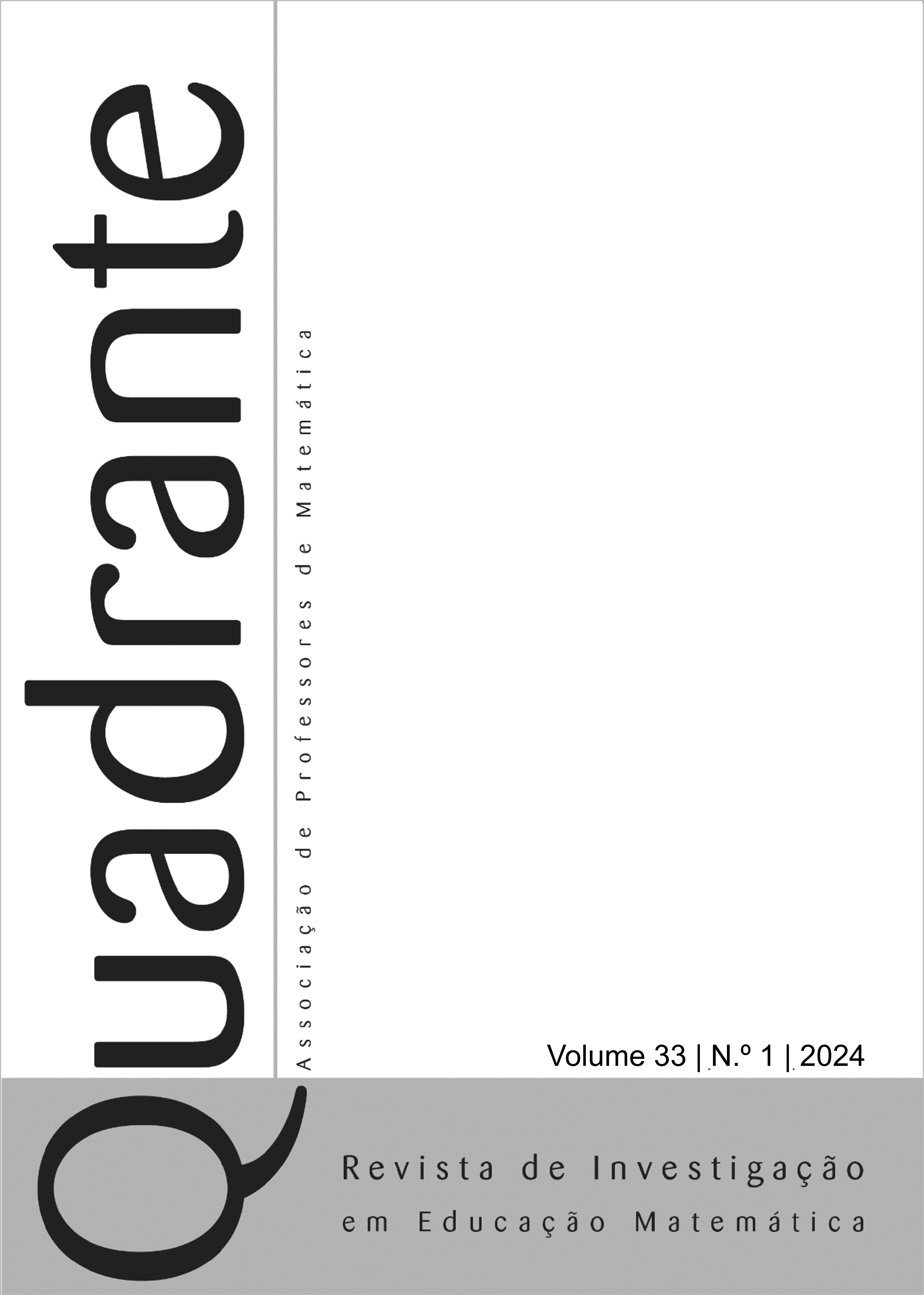The concept of derivative in the Algebra Textbook by José Sebastião e Silva and José da Silva Paulo
DOI:
https://doi.org/10.48489/quadrante.32834Keywords:
differential calculus, history of teaching, textbookAbstract
This article aims to characterize the approach of the concept of derivative proposed in the Algebra Textbook for the high school, in Portugal at the time, by the authors José Sebastião e Silva and José da Silva Paulo. In this study, we focus on the textbook (in its editions from 1956 to 1974) and Mária Almeida’s school notebook, considered as structuring elements of the school culture, and David Tall’s theory of the three worlds. The qualitative methodology followed the following steps: search for sources (books and school notebooks), organization of sources, selection of significant units and interpretation of data. I concluded that there were no changes in the approach to the concept of derivative from 1956 to 1974 and that it can be understood as embodied mixed with symbolic and formal, in the language of Tall.
References
Abreu, M. D. O. H. G. (2011). Compêndio de Matemática de Sebastião e Silva: Cálculo Diferencial. (Dissertação de Mestrado em Ensino da Matemática). Universidade de Aveiro.
Aires, A. P. (2006). O conceito de derivada no ensino secundário em Portugal ao longo do século XX. (Tese de doutoramento). Universidade de Salamanca.
Aires, A. P., & Santiago, A. E. (2011). As primeiras aplicações das derivadas nos manuais escolares do Ensino Secundário. In J. M. Matos, & M. Saraiva (Eds.), Actas do I Congresso Ibero-Americano de História da Educação Matemática, (pp. 47-58). UIED, Universidade Nova de Lisboa. https://www.uied.fct.unl.pt/sites/www.uied.fct.unl.pt/files/Livros%20UIED/Actas-CIHEM%20ordenado.pdf
Almeida, A. J., & Matos, J. M. (2014). A matemática nos programas do ensino não-superior (1835-1974). UIED e APM.
Almeida, M. C. R. C. (1978). Caderno de Matemática manuscrito. Acervo pessoal da autora.
Alves, M. T. (1952). O programa de Matemática da actual reforma do ensino liceal. Gazeta de Matemática, 51, 7-9.
Artigue, M. (2011). Les questions de développement curriculaire à travers un exemple: l’enseignement de l’analyse en France au lycée depuis le début du XXème siècle. Quadrante, 20(1), 7-29. https://doi.org/10.48489/quadrante.22861
Barros, L. (1958). Crítica de livros. Gazeta de Matemática, 71, 44-46.
Bourlet, C. (1907). Précis d’Algèbre. Librairie Hachette.
Dowling, P. (1998). The Sociology of Mathematics Education: mathematical myths/pedagogical texts. The Falmer Press.
Ferreira, J. C., Guerreiro, J. S., & Oliveira, J. S. (1999). Nota biográfica. In J. S. Silva, Textos Didácticos (pp. 3-5). Fundação Calouste Gulbenkian.
Garcia, M. M., Anjos, A. O., & Ruivo, A. F. (1976). Compêndio de Matemática. 2º ano, curso complementar. Empresa Literária Fluminense.
Gouveia, M. C. (2023). O brilho enigmático de Maria Teodora Baptista Alves. REMATEC – Revista de Matemática, Ensino e Cultura, 43, e2023025. https://doi.org/10.37084/REMATEC.1980-3141.2023.n43.pe2023028.id496
Klein, F. (1908). Elementarmathematik vom höheren Standpunkte aus. Teubner.
Klein, F. (2009). Matemática Elementar de um ponto de vista superior. (Vol. 1, Aritmética). Lisboa: Sociedade Portuguesa de Matemática.
Meyers, G. (1992). Textbooks and the sociology of scientific knowledge. English for Specific Purposes, 11(1), 3-17.
Silva, C. M. S. (2023). Limites: Uma breve passagem nos livros brasileiros do ensino secundário. Acervo: Boletim do centro de documentação do GHEMAT-SP, 5, 1-25.
Silva, J. S. (1951). A análise infinitesimal e o ensino secundário. Gazeta de Matemática, 49, 1-4.
Silva, J. S. (1962). Sur l’introduction des mathématiques modernes dans l’enseignement secondaire. Gazeta de Matemática, 88, 25-26.
Silva, J. S. (1975). Guia para a utilização do Compêndio de Matemática (1º vol.). Edição GEP.
Silva, J. S., & Paulo, J. S. (1957). Compêndio de Álgebra. (3º ciclo dos liceus, v. 1, 6º ano). (2ª Ed.). Livraria Popular de Francisco Franco.
Silva, J. S., & Paulo, J. S. (1974). Compêndio de Álgebra. (3º ciclo dos liceus, v.1, 6º ano). (2ª Ed.). Livraria Popular de Francisco Franco.
Tall, D. (1992). The transition to advanced mathematical thinking: functions, limits, infinity and proof. In D. A. Grouws (Ed.), Handbook of Research on Mathematics Teaching and Learning, (pp. 495-511). Macmillan.
Tall, D. (2002). Using technology to support an embodied approach to learning concepts in Mathematics. In L. M. Carvalho, & L. C. Guimarães (Orgs.), História e Tecnologia no Ensino de Matemática (pp. 1-28). IME-UERJ.
Tall, D. (2013). How humans learn to think mathematically: Exploring the three worlds of mathematics. Cambridge University Press. https://doi.org/10.1017/CBO9781139565202
Teixeira, A. (2010). Os manuais escolares de Matemática nos liceus portugueses (1947-1974). Cadernos de História da Educação, 9(2), 309-328. https://seer.ufu.br/index.php/che/article/view/11448/6726
Vidal, D. (2009). No interior da sala de aula: ensaio sobre cultura e prática escolar. Currículo sem fronteiras, 9(1), 25-41. http://www.Currículosemfronteiras.org/vol9iss1articles/2-vidal.pdf
Viñao, A. (2008). Os cadernos escolares como fonte histórica: aspectos metodológicos e historiográficos. In A. C. Mignot (Org.), Cadernos à vista: escola, memória e cultura. EDUERJ.
Downloads
Published
How to Cite
Issue
Section
License
Copyright (c) belongs to Quadrante. Nevertheless, we encourage articles to be published in institutional or personal repositories as long as their original publication in Quadrante is identified and a link to the journal's website is included.










